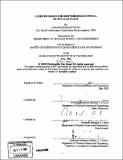| dc.contributor.advisor | Michael J. Driscoll. | en_US |
| dc.contributor.author | Hoag, Christopher Ian | en_US |
| dc.contributor.other | Massachusetts Institute of Technology. Dept. of Nuclear Science and Engineering. | en_US |
| dc.date.accessioned | 2008-04-23T14:37:33Z | |
| dc.date.available | 2008-04-23T14:37:33Z | |
| dc.date.copyright | 2005 | en_US |
| dc.date.issued | 2006 | en_US |
| dc.identifier.uri | http://hdl.handle.net/1721.1/41269 | |
| dc.description | Thesis (S.M.)--Massachusetts Institute of Technology, Dept. of Nuclear Science and Engineering, June 2006. | en_US |
| dc.description | Includes bibliographical references (p. 122-125). | en_US |
| dc.description.abstract | The objective of this thesis was to design a canister for the disposal of spent nuclear fuel and other high-level waste in deep borehole repositories using currently available and proven oil, gas, and geothermal drilling technology. The canister is suitable for disposal of various waste forms, such as fuel assemblies and vitrified waste. The design addresses real and perceived hazards of transporting and placing high-level waste, in the form of spent reactor fuel, into a deep igneous rock environment with particular emphasis on thermal performance. The proposed boreholes are 3 to 5 km deep, in igneous rock such as granite. The rock must be in a geologically stable area from a volcanic and tectonic standpoint, and it should have low permeability, as shown in recent data taken from a Russian deep borehole. Although deep granite should remain dry, water in flooded boreholes is expected to be reducing, but potentially corrosive to steel. However, the granite and plug are the containment barrier, not the canister itself. The canisters use standard oil drilling casings. The inner diameter is 315.32mm in order to accommodate a PWR assembly with a width of 214mm. At five meters tall, each canister holds one PWR assembly. The canister thickness is 12.19mm, with an outer diameter of 339.7mm. A liner can extend to the bottom of the emplacement zone to aid in retrievability. The liner has an outer diameter of 406.4mm and a thickness of 9.52mm. The standard drill bit used with a liner of this size has an outer diameter of 444.5mm. Sample calculations were performed for a two kilometer deep emplacement zone in a four kilometer deep hole for the conservative case of PWR fuel having a burnup of 60,000 MWd/kg, cooled ten years before emplacement. | en_US |
| dc.description.abstract | (cont.) Tensile and buckling stresses were calculated, and found to be tolerable for a high grade of steel used in the drilling industry. In the thermal analysis, a maximum borehole wall temperature of 2400C is computed from available correlations and used to calculate a maximum canister centerline temperature of 3370C, or 3190C if the hole floods with water. Borehole repository construction costs were calculated to be on the rate of 50 $/kg spent fuel, which is competitive with Yucca Mountain construction costs. Recommendations for future work on the very deep borehole concept are suggested in the areas of thermal analysis, plugging, corrosion of the steel canisters, site selection, and repository economics. | en_US |
| dc.description.statementofresponsibility | by Christopher Ian Hoag. | en_US |
| dc.format.extent | 125 p. | en_US |
| dc.language.iso | eng | en_US |
| dc.publisher | Massachusetts Institute of Technology | en_US |
| dc.rights | M.I.T. theses are protected by
copyright. They may be viewed from this source for any purpose, but
reproduction or distribution in any format is prohibited without written
permission. See provided URL for inquiries about permission. | en_US |
| dc.rights.uri | http://dspace.mit.edu/handle/1721.1/7582 | en_US |
| dc.subject | Nuclear Science and Engineering. | en_US |
| dc.title | Canister design for deep borehole disposal of nuclear waste | en_US |
| dc.type | Thesis | en_US |
| dc.description.degree | S.M. | en_US |
| dc.contributor.department | Massachusetts Institute of Technology. Department of Nuclear Science and Engineering | |
| dc.identifier.oclc | 213435157 | en_US |
